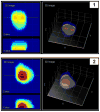Prostate mechanical imaging: a new method for prostate assessment
- PMID: 18342178
- PMCID: PMC2323601
- DOI: 10.1016/j.urology.2007.11.021
Prostate mechanical imaging: a new method for prostate assessment
Abstract
Objectives: To evaluate the ability of prostate mechanical imaging (PMI) technology to provide an objective and reproducible image and to assess the prostate nodularity.
Methods: We evaluated the PMI device developed by Artann Laboratories in a pilot clinical study. For the 168 patients (ages 44 to 94) who presented to an urologist for prostate evaluation, PMI-produced images and assessment of prostate size, shape, consistency/hardness, mobility, and nodularity were compared with digital rectal examination (DRE) findings. The PMI and DRE results were further tested for correlation against a transrectal ultrasound of the prostate (TRUS) guided biopsy for a subgroup of 21 patients with an elevated prostate-specific antigen level.
Results: In 84% of the cases, the PMI device was able to reconstruct three-dimensional (3D) and 2D cross-sectional images of the prostate. The PMI System and DRE pretests were able to determine malignant nodules in 10 and 6 patients, respectively, of the 13 patients with biopsy-confirmed malignant inclusions. The PMI System findings were consistent with all 8 biopsy negative cases, whereas the DRE had 1 abnormal reading for this group. The correlation between PMI and DRE detection of palpable nodularity was 81%, as indicated by the area under the receiver operating characteristic curve. Estimates of the prostate size provided by PMI and DRE were statistically significantly correlated.
Conclusions: The PMI has the potential to enable a physician to obtain, examine, and store a 3D image of the prostate based on mechanical and geometrical characteristics of the gland and its internal structures.
Figures



Similar articles
-
Prostate mechanical imaging: 3-D image composition and feature calculations.IEEE Trans Med Imaging. 2006 Oct;25(10):1329-40. doi: 10.1109/tmi.2006.880667. IEEE Trans Med Imaging. 2006. PMID: 17024836 Free PMC article.
-
Interexaminer reliability and validity of a three-dimensional model to assess prostate volume by digital rectal examination.Urology. 2001 Jun;57(6):1087-92. doi: 10.1016/s0090-4295(01)00965-7. Urology. 2001. PMID: 11377314 Clinical Trial.
-
Correlation between prostate size estimated by digital rectal examination and measured by transrectal ultrasound.Urology. 1997 Apr;49(4):548-57. doi: 10.1016/s0090-4295(97)00031-9. Urology. 1997. PMID: 9111624 Clinical Trial.
-
Evaluation of prostate specific antigen density and transrectal ultrasonography-guided biopsies in 100 consecutive patients with a negative digital rectal examination and intermediate serum prostate specific antigen levels.Int J Urol. 1997 Jul;4(4):362-7. doi: 10.1111/j.1442-2042.1997.tb00209.x. Int J Urol. 1997. PMID: 9256325 Review.
-
Transperineal biopsy devices in people with suspected prostate cancer - a systematic review and economic evaluation.Health Technol Assess. 2024 Oct;28(60):1-213. doi: 10.3310/ZKTW8214. Health Technol Assess. 2024. PMID: 39364806 Free PMC article.
Cited by
-
Characterization of Perineum Elasticity and Pubic Bone-Perineal Critical Distance with a Novel Tactile Probe: Results of an Intraobserver Reproducibility Study.Open J Obstet Gynecol. 2020 Apr;10(4):493-503. doi: 10.4236/ojog.2020.1040044. Open J Obstet Gynecol. 2020. PMID: 32395394 Free PMC article.
-
Cost-effective screening for breast cancer worldwide: current state and future directions.Breast Cancer (Auckl). 2008;1:91-9. doi: 10.4137/bcbcr.s774. Epub 2008 Jul 2. Breast Cancer (Auckl). 2008. PMID: 19578481 Free PMC article.
-
Vaginal tactile imaging: A review.Pelviperineology. 2023 Apr;42(1):28-42. doi: 10.34057/ppj.2023.42.01.2022-5-2. Pelviperineology. 2023. PMID: 39574944 Free PMC article.
-
Shear wave dispersion ultrasonic vibrometry for measuring prostate shear stiffness and viscosity: an in vitro pilot study.IEEE Trans Biomed Eng. 2011 Feb;58(2):235-42. doi: 10.1109/TBME.2010.2053928. Epub 2010 Jun 28. IEEE Trans Biomed Eng. 2011. PMID: 20595086 Free PMC article.
-
Mechanical Imaging - a Technology for 3-D Visualization and Characterization of Soft Tissue Abnormalities. A Review.Curr Med Imaging Rev. 2012 Feb 1;8(1):64-73. doi: 10.2174/157340512799220571. Curr Med Imaging Rev. 2012. PMID: 24058326 Free PMC article.
References
-
- Stephenson RA. Prostate cancer trends in the era of prostate-specific antigen. An update of incidence, mortality, and clinical factors from the SEER database. Urol Clin North Am. 2002;29:173–81. - PubMed
-
- Ilic D, O'Connor D, Green S, et al. Screening for prostate cancer. Cochrane Database Syst Rev. 2006;3:CD004720. - PubMed
-
- Gohagan JK, Prorok PC, Hayes RB, et al. The Prostate, Lung, Colorectal and Ovarian (PLCO) Cancer Screening Trial of the National Cancer Institute: history, organization, and status. Control Clin Trials. 2000;21:251S–272S. - PubMed
-
- Schroder FH. The European Screening Study for Prostate Cancer. Can J Oncol. 1994;4 1:102–5. discussion 106-9. - PubMed
-
- Draisma G, Boer R, Otto SJ, et al. Lead times and overdetection due to prostate-specific antigen screening: estimates from the European Randomized Study of Screening for Prostate Cancer. J Natl Cancer Inst. 2003;95:868–78. - PubMed
Publication types
MeSH terms
Grants and funding
LinkOut - more resources
Full Text Sources
Medical

